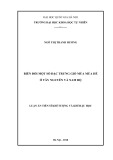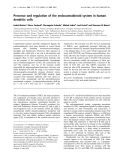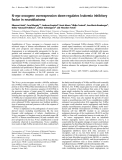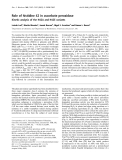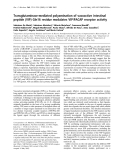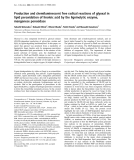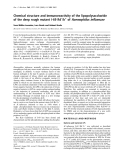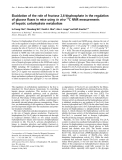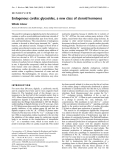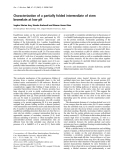
BioMed Central
Page 1 of 6
(page number not for citation purposes)
Journal of Translational Medicine
Open Access
Research
Short term effects of milrinone on biomarkers of necrosis,
apoptosis, and inflammation in patients with severe heart failure
David E Lanfear*1, Reema Hasan2, Ramesh C Gupta1, Celeste Williams1,
Barbara Czerska1, Cristina Tita1, Rasha Bazari3 and Hani N Sabbah1
Address: 1Department of Internal Medicine, Division of Cardiology, Henry Ford Hospital, Detroit, Michigan, USA, 2Department of Internal
Medicine, Division of Cardiology, Providence Hospital, Southfield, Michigan, USA and 3Department of Internal Medicine, Division of Cardiology,
Beaumont Hospital, Royal Oak, Michigan, USA
Email: David E Lanfear* - dlanfea1@hfhs.org; Reema Hasan - Reema.Hasan@providence-stjohnhealth.org;
Ramesh C Gupta - rgupta1@hfhs.org; Celeste Williams - cwillia6@hfhs.org; Barbara Czerska - bczersk1@hfhs.org;
Cristina Tita - ctita1@hfhs.org; Rasha Bazari - Rasha.Bazari@beaumont.edu; Hani N Sabbah - hsabbah1@hfhs.org
* Corresponding author
Abstract
Introduction: Inotropes are associated with adverse outcomes in heart failure (HF), raising
concern they may accelerate myocardial injury. Whether biomarkers of myocardial necrosis,
inflammation and apoptosis change in response to acute milrinone administration is not well
established.
Methods: Ten patients with severe HF and reduced cardiac output who were to receive milrinone
were studied. Blood samples were taken just before initiation of milrinone and after 24 hours of
infusion. Dosing was at the discretion of the patient's attending physician (range 0.25–0.5 mcg/kg/
min). Plasma measurements of troponin, myoglobin, N-terminal-pro-BNP, interleukin-6, tumor
necrosis factor-α, soluble Fas, and soluble Fas-ligand were performed at both time points.
Results: Troponin was elevated at baseline in all patients (mean 0.1259 ± 0.17 ng/ml), but there
was no significant change after 24 hours of milrinone (mean 0.1345 ± 0.16 ng/ml, p = 0.44). There
were significant improvements in interleukin-6, tumor necrosis factor-α, soluble Fas, and soluble
Fas-ligand (all p < 0.05) indicative of reduced inflammatory and apoptotic signaling compared to
baseline.
Conclusion: In conclusion, among patients with severe HF and low cardiac output, ongoing
myocardial injury is common, and initiation of milrinone did not result in exacerbation of
myocardial injury but instead was associated with salutary effects on other biomarkers.
Introduction
Intravenous inotropic agents (inotropes) such as dob-
utamine and milrinone can produce improvements in car-
diac output and patient's symptoms via increased
contractility and heart rate. However, these type of agents
have also been associated increased arrhythmia risk and
other adverse outcomes in heart failure (HF) [1-3]. This
raises concern that inotropes may cause or contribute to
myocardial destruction through worsening ischemia,
increased neurohormonal activation, or via other adverse
Published: 29 July 2009
Journal of Translational Medicine 2009, 7:67 doi:10.1186/1479-5876-7-67
Received: 30 April 2009
Accepted: 29 July 2009
This article is available from: http://www.translational-medicine.com/content/7/1/67
© 2009 Lanfear et al; licensee BioMed Central Ltd.
This is an Open Access article distributed under the terms of the Creative Commons Attribution License (http://creativecommons.org/licenses/by/2.0),
which permits unrestricted use, distribution, and reproduction in any medium, provided the original work is properly cited.

Journal of Translational Medicine 2009, 7:67 http://www.translational-medicine.com/content/7/1/67
Page 2 of 6
(page number not for citation purposes)
pathways such as inflammation and apoptosis. Biomark-
ers may provide a glimpse into this pathophysiology with-
out the need for tissue sampling. Modern, high-sensitivity
troponin assays can detect even small amounts of myocar-
dial necrosis and natriuretic peptides are well known indi-
cators of cardiac dysfunction and filling pressures. In
addition, certain other biomarkers are known to be indi-
cators of inflammation and apoptosis, two processes
which accumulating data suggest are important in the
pathophysiology of HF.
It is well recognized that heart failure leads to increased
circulating levels of pro-inflammatory cytokines, such as
tumor necrosis factor α (TNFα) and Interleukin 6 (IL6),
which may cause or potentiate progressive cardiovascular
injury, [4] and have been associated with increased mor-
bidity and mortality in patients with HF [5]. More recently
apoptosis has been investigated as a pathophysiologic
mechanism in HF. A key apoptotic signaling system, the
Fas/Fas ligand system, shows increased activity in HF
patients and correlates to disease severity [6,7]. To briefly
summarize, soluble Fas-Ligand (sFas-L) binding to mem-
brane-bound Fas triggers apoptosis, whereas soluble Fas
(sFas) competes with membrane-bound Fas for ligand
binding, therefore reducing apoptotic signaling.
How these biomarkers change in response to administra-
tion of a positive inotropic agent in severe HF is not firmly
established. There have been several studies examining
natriuretic peptide levels and/or inflammatory markers
during inotrope administration with inconsistent results
[8-11]. Adding complexity to this picture is data indicat-
ing that the specific inotrope used is important as well. For
example, there are studies suggesting differences in
biomarker effects between dobutamine vs. levosimendan
[12], and dobutamine vs. milrinone [13]. Furthermore,
there is little or no data regarding the effect of milrinone
on apoptosis markers, or whether high-sensitivity tro-
ponin may reveal sub-clinical cardiac injury due to ino-
trope initiation. We sought to determine the effect of
initiating milrinone on biomarkers of myocardial func-
tion (N-terminal pro-B-type Natriuretic Peptide), myocar-
dial necrosis (troponin I, myoglobin), inflammation
(TNFα, IL6) and apoptosis (sFas, sFas-L).
Methods
Patients
This study was approved by the Institutional Review
Board, and all patients gave written informed consent.
Severe heart failure patients undergoing non-urgent right
heart catheterization were screened for inclusion from
June 2006 to November 2007. After catheterization,
patients who were planned by their physician to receive
intravenous milrinone due to reduced cardiac output were
approached for study participation. A total of 10 patients
with NYHA Class IV symptoms and cardiac index <2.0 L/
m/M2 were enrolled. After the initial procedure, patients
were admitted to the cardiac intensive care with the cath-
eter remaining in place for drug initiation and monitoring
as per standard care. Exclusion criteria included exposure
to intravenous inotropic support within 1 month and ina-
bility to give written informed consent. After conclusion
of study participation all patients care continued to be at
the discretion of the attending physician, including ino-
trope administration and dosing.
Procedures
All treatments including milrinone dosing was at the dis-
cretion of the patient's attending physician, with initial
dosing between 0.25 and 0.5 μg/kg/min. Patients were
observed for at least 24 h. Blood samples were obtained
by standard venipuncture from all patients just prior to
milrinone initiation (day 0) and after 24 hours of contin-
uous infusion (day 1). Blood samples were centrifuged,
plasma aliquoted, and frozen at -70°C until the time of
testing. Plasma levels of Troponin I (TnI) and myoglobin
(Myo) were measured using sandwich immunoassays
with chemiluminescence using the Centaur instrument
(Siemens Corporation, Deerfield, Illinois). TnI levels were
replicated on each sample to assess precision of measure-
ment, yielding an inter-assay correlation coefficient
>0.995. TNFα, sFas, sFas-L and IL6 were determined in
plasma using double antibody sandwich Enzyme Linked
Immunosorbant Assays (ELISA). NTproBNP level was
determined in plasma based on competitive ELISA as
described elsewhere [14]. The concentration of each
biomarker was assayed using commercially available
assay kits according to manufacturer protocol and using
standard curves and software. The kits for NTproBNP
(fmol/ml) were purchased from ALPCO Diagnostics,
Salem, New Hampshire; for IL-6 (pg/ml) and TNFα (pg/
ml) from Assay Designs Inc., Ann Arbor, Michigan; and
for sFas (pg/ml) and sFas-L (pg/ml) from R&D Systems,
Inc, Minneapolis, Minnesota.
Statistical Analysis
Statistical comparisons were made between baseline lev-
els and 24 hour levels using the paired t-test. P values <
0.05 were considered significant. Power estimate for TnI
was 90% to detect a mean difference between time-points
as small as 0.02 ng/ml (using experimentally determined
correlation coefficient in calculations). All statistics were
calculated using SAS 9.1.3. All data are reported as the
mean ± standard deviation.
Results
Baseline characteristics are shown in Table 1. Overall this
was a very ill patient cohort with mean ejection fraction of
16%, pulmonary capillary wedge pressure of 30 mmHg
and cardiac index of 1.81 L/min/m2. TnI and B-type Natri-

Journal of Translational Medicine 2009, 7:67 http://www.translational-medicine.com/content/7/1/67
Page 3 of 6
(page number not for citation purposes)
uretic Peptide (BNP) levels were elevated at baseline in all
patients (TnI range 0.0205–0.56 ng/ml, mean 0.1259 ±
0.17 ng/ml; mean BNP range 73 to 1620, mean 803 ± 630
pg/ml). On average there was a large improvement in
hemodynamics over 24 hours with average cardiac index
increasing to 2.5 L/m/M2, and mean pulmonary capillary
wedge pressure decrease over that period to 23 mmHg.
The change in each biomarker for each participant over
the study period is depicted in Figure 1. Compared to
baseline, NT-pro BNP levels decreased by 47.5 fmol/ml or
55% (from 86.5 to 39.0 fmol/ml, p < 0.0001). There was
no significant change in mean TnI or MYO after 24 hours
of milrinone compared to baseline (mean TnI 0.1345 ±
0.16, ↑0.0086 ng/ml or 6.8% compared to baseline, p =
0.44; MYO ↓8.8 ng/ml or 13%, p = 0.19). In contrast there
were significant reductions in inflammatory and apop-
totic signaling after Milrinone infusion. Levels of IL6 and
TNFα were reduced by roughly half after 24 hours of mil-
rinone (IL6 ↓31 pg/ml or 56%, p = 0.0023; TNF↓149 pg/
ml or 53%, p = 0.028). In terms of apoptotic signaling,
sFas, sFas-L, and the ratio of sFas:sFas-L all changed signif-
icantly in a favorable direction over the study period. Sol-
uble Fas levels increased 18% (p = 0.00074) while Fas-
Ligand levels decreased 20% (p = 0.044). As a result the
sFas:sFas-L ratio increased by 45% (p = 0.0016), consist-
ent with reduced apoptotic signaling. Neither the milri-
none dose nor the presence of oral vasodilators were
associated with differences in biomarker changes (all p >
0.1).
Discussion
In this sample of patients with severe HF and reduced car-
diac output, initiation of milrinone therapy did not result
in changes indicative of accelerated myocardial necrosis,
but instead was associated with salutary effects on all the
other markers. As might be expected, inotropic support
led to improvements in hemodynamic status reflected in
increased cardiac output and reduction in NTproBNP lev-
els. Surprisingly, there was no significant change in TnI or
MYO after 24 hours of milrinone compared to baseline.
On the other hand, there were significant reductions in
inflammatory and apoptotic signaling with milrinone
infusion. This is the first data we are aware of to show
improvements in apoptotic markers with milrinone infu-
sion.
Table 1: Patient Characteristics
Characteristic Average (± SD)
Age (yrs) 52 (± 17)
Sex (male/female) 8/2
Ejection Fraction (%) 16% (± 8.18)
Ischemic/Non Ischemic etiology(%) 3 (30%)/7 (70%)
Beta adrenergic antagonist 9 (90%)
Angiotensin converting enzyme inhibitor or angiotensin receptor blocker 3 (30%)
Furosemide 8 (80%)
Furosemide continuous infusion 2 (20%)
Creatinine (mg/dL) 1.73 (± 0.83)
BNP (ng/ml) 803 (± 630)
Pulmonary capillary wedge pressure, baseline (mmHg) 30 (± 8.5)
Pulmonary capillary wedge pressure, @ 24 hours (mmHg) 23 (± 5.0)
Cardiac Index, baseline (L/min/m2)1.81 (± 0.63)
Cardiac Index @ 24 hours (L/min/m2)2.51 (± 0.74)

Journal of Translational Medicine 2009, 7:67 http://www.translational-medicine.com/content/7/1/67
Page 4 of 6
(page number not for citation purposes)
Our findings are notable in several ways. The fact that all
of the subjects had measurable TnI at baseline suggests
that patients with very advanced HF have ongoing myo-
cardial injury. The lack of worsening of the TnI leak sug-
gests that milrinone does not exacerbate the underlying
pathologic process in these patients, at least in the short
term. This should be interpreted with caution however,
since the majority of the study subjects had a non-
ischemic etiology for their HF. This is an especially impor-
tant factor since patients with ischemic disease seemed to
be at greater risk in the OPTIME study [15]. The marked
improvements seen in inflammatory and apoptotic mark-
ers were somewhat surprising, suggesting a possible bene-
fit of this therapy in properly selected patients. Our
patients were extremely ill with low cardiac index and evi-
dence of ongoing myocardial damage as mentioned
above. It is possible that in such a state, intervening with
inotropes may mitigate the overall neurohormonal activa-
tion (including inflammation). If this is the case, it is also
possible that this potential benefit may outweigh the pos-
sible adverse effects of inotropic agents in the short term.
An additional complexity is that the witnessed effects may
not be applicable to all inotropes but instead could be
specific to milrinone. For example, milrinone is known to
be a more potent vasodilator compared to dobutamine.
Biomarker changes from baseline (Day 0) to 24 hours of infusion (Day 1)Figure 1
Biomarker changes from baseline (Day 0) to 24 hours of infusion (Day 1).
0
200
400
600
800
1000
1200
Day 0 Day 1
Į
0
20
40
60
80
100
120
Day 0 Day 1
0
20
40
60
80
100
120
140
Day 0 Day 1
!!
0
10
20
30
40
50
60
Day 0 Day 1
"#$%&
''
0
0.1
0.2
0.3
0.4
0.5
0.6
Day 0 Day 1
''
0
50
100
150
200
250
Day 0 Day 1
()**
!+
0
2000
4000
6000
8000
10000
12000
14000
Day 0 Day 1
,"#
-'
0
50
100
150
200
250
300
350
400
Day 0 Day 1
,%,%, $%& .%
!

Journal of Translational Medicine 2009, 7:67 http://www.translational-medicine.com/content/7/1/67
Page 5 of 6
(page number not for citation purposes)
This relatively enhanced vasodilitation could theoretically
account for a more favorable impact on biomarkers. In
addition while it is impossible with to completely sepa-
rate the hemodynamic improvement from other potential
effects of milrinone, there is some previous data that
reveal differences between inotropic agents in terms of
biomarker changes despite similar hemodynamic proper-
ties. For example, dobutamine failed to decrease
NTproBNP or TNF while levosimendan significantly
decreased both in one randomized study [12]. On the
other hand, levosimendan infusion decreased sFAS while
our data showed a significant increase, suggesting a more
favorable effect of milrinone.
Furthermore, previous in-vitro data indicates that phos-
phodiesterase inhibition suppressed TNFα production in
mononuclear cells [16,17]. These facts together are con-
sistent with the possibility of a phosphodiesterase-specific
effect, perhaps via inflammatory or other pathways, as
opposed to a more general inotrope effect based solely on
improved hemodynamics.
There are limitations of this study that should be noted.
First, the study was non-random and uncontrolled in
design. Since inotropic agents are currently considered to
carry excess risk and thus are used only when thought to
be absolutely clinically necessary, randomization and pla-
cebo control was not practical. Another related concern is
whether standard therapy, particularly increased loop diu-
retic dosing, could explain the findings and confound the
milrinone effects. In terms of TnI levels, there is no reason
to believe that standard therapy would obscure detection
of increased myocardial necrosis. While standard care
with higher diuretic dosing likely contributed the lower-
ing of NTproBNP levels, it is unlikely to explain the
changes seen in the inflammatory and apoptotic markers.
Not only has diuretic use been shown to increase neuro-
hormonal activation [18]. but a randomized placebo con-
trolled study of levosimendan in decompensated HF
patients revealed that standard therapy including diuretic
did not reduce IL6 or TNFα, nor change sFas levels (in
contrast to levosimendan) [19]. Other standard therapies
such as ACE-inhibitors and beta adrenergic antagonists
are very unlikely to be manipulated significantly in this
setting due to the severity of the subject's HF. The second
main limitation is the small sample size. While the size
precludes examination of clinical endpoints, our power
estimates indicate that the sample size of 10 was adequate
for the planned analyses of biomarkers reported. It is pos-
sible that the observation window was too short to
observe troponin changes but we feel this is unlikely given
that standard 'rule out' of myocardial infarction (necrosis)
involves troponin measurements that are typically <12
hours apart. Finally, extrapolation of our results to groups
not adequately represented should be avoided. Specifi-
cally, these subjects were end-stage patients and mostly of
non-ischemic etiology. Consequently, this data does not
give as much insight regarding inotrope use in the setting
of more routine decompensated heart failure, and the
effect milrinone in ischemic subset of patients deserves
further investigation.
Conclusion
Initiation of milrinone therapy in patients with severe
heart failure and reduced cardiac output did not result in
changes indicative of accelerated myocardial injury. On
the contrary, it was associated with significant improve-
ment in biomarkers of the inflammatory and apoptotic
pathways. This data does not support the hypothesis that
inotrope use is inherently detrimental in all cases, but
instead suggests that properly selected patients may have
benefits from this treatment, at least in the short-term.
Placebo-controlled, randomized studies in patients with
low cardiac output are needed to further establish the
potential benefits and adverse consequences of the use of
positive inotropic agents in this population. Additional
studies are also needed to assess longer-term biomarker
trends during chronic milrinone infusions and the rela-
tionship to clinical outcomes.
Competing interests
The authors declare that they have no competing interests.
Authors' contributions
DL conceived of the study, participated in design, coordi-
nation, data interpretation, performed the statistical anal-
ysis, and drafted the manuscript.
RH participated in design and coordination of the study,
data collection, and critically revised the manuscript. RG
performed the molecular assays and critically revised the
manuscript. CW participated in data collection, interpre-
tation, and critically revised the manuscript. BC partici-
pated in data collection, interpretation, and critically
revised the manuscript. CT participated in data collection,
interpretation, and critically revised the manuscript. RB
participated in design and coordination of the study, data
collection, and critically revised the manuscript. HS con-
ceived of the study, participated in design, interpretation
of data, and critically revised the manuscript. All authors
read and approve of the final manuscript.
Acknowledgements
This work was supported in part by an NIH grant (K23HL085124).
References
1. Cohn JN, Goldstein SO, Greenberg BH, Lorell BH, Bourge RC, Jaski
BE, Gottlieb SO, McGrew F 3rd, DeMets DL, White BG: A dose-
dependent increase in mortality with vesnarinone among
patients with severe heart failure. Vesnarinone Trial Investi-
gators. N Engl J Med 1998, 339:1810-6.

